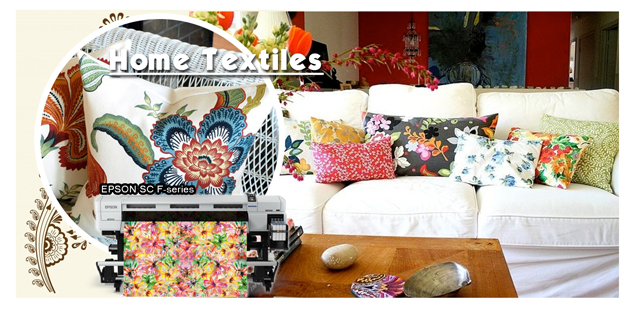Different types ink for different types fabric
The fabrics being used in the textile printing industry are so diverse that there could be thousands of textile types used. Some are from a natural source, some are man-made, some are coated and others may be pretreated or post-treated depending on its final application or manufacturing procedures. So how can you simplify the printing process? The answer lies in printing ink.
In the current situation in order to print on different types of textiles, whether analog or digital, you would need different types of inks. Each ink is suitable for different types of fabric. On top of the printing quality, the printer must ensure the stability of the ink on the fabric including wash and rub resistance as well as non-fading qualities essential for long term use.
 The inks used for printing on textiles are divided into two types: dye or pigment, and both are based on water as its main carrier. With dye inks there needs to be a distinct affinity between the fabric type and the ink that is used for the print, because different inks do not adhere to specific fabric types. Cotton and silk fabrics require reactive dye inks while silk and nylon require acid dye ink. Polyester requires disperse dyes such as used in sublimation printing.
The inks used for printing on textiles are divided into two types: dye or pigment, and both are based on water as its main carrier. With dye inks there needs to be a distinct affinity between the fabric type and the ink that is used for the print, because different inks do not adhere to specific fabric types. Cotton and silk fabrics require reactive dye inks while silk and nylon require acid dye ink. Polyester requires disperse dyes such as used in sublimation printing.
This type of ink specification limits the industry's ability to provide effective printing solutions and limits the ability to print on blended fabrics.
Pigment ink, however, as opposed to dyes, are suitable for many types of fabric printing. In fact, a small number of manufacturers now offer pigment water based ink for digital textile printing which are suitable for a large array of fabrics. One ink for all fabrics is the newest revolution for the textile market since it takes textile printing into the digitized era.
The ability to print on a large amount of fabrics is achievable because of the way pigment ink printing is made. Instead of penetrating the fabric and binding to it as dyes do, the pigments bind to the top layer of the fabric only in a micron thick layer. This allows the print to be done on virtually all types of fabric, providing the correct pretreatment is done. The thickness of the layer and it's bind to the fabric determine the feel of the end result, where a thick layer will result in the loss of the fabric's natural feel.
More info:
Website: www.skyimagepaper.com
Company Name: Fei Yue Digital Technology Co.,LTD
E-mail: sales@feiyuepaper.com
Tel: 86-025-86628894
Whatsapp: +86 18252072197
Address: Central Road 323, Nanjing, Jiangsu, China
In the current situation in order to print on different types of textiles, whether analog or digital, you would need different types of inks. Each ink is suitable for different types of fabric. On top of the printing quality, the printer must ensure the stability of the ink on the fabric including wash and rub resistance as well as non-fading qualities essential for long term use.
 The inks used for printing on textiles are divided into two types: dye or pigment, and both are based on water as its main carrier. With dye inks there needs to be a distinct affinity between the fabric type and the ink that is used for the print, because different inks do not adhere to specific fabric types. Cotton and silk fabrics require reactive dye inks while silk and nylon require acid dye ink. Polyester requires disperse dyes such as used in sublimation printing.
The inks used for printing on textiles are divided into two types: dye or pigment, and both are based on water as its main carrier. With dye inks there needs to be a distinct affinity between the fabric type and the ink that is used for the print, because different inks do not adhere to specific fabric types. Cotton and silk fabrics require reactive dye inks while silk and nylon require acid dye ink. Polyester requires disperse dyes such as used in sublimation printing.This type of ink specification limits the industry's ability to provide effective printing solutions and limits the ability to print on blended fabrics.
Pigment ink, however, as opposed to dyes, are suitable for many types of fabric printing. In fact, a small number of manufacturers now offer pigment water based ink for digital textile printing which are suitable for a large array of fabrics. One ink for all fabrics is the newest revolution for the textile market since it takes textile printing into the digitized era.
The ability to print on a large amount of fabrics is achievable because of the way pigment ink printing is made. Instead of penetrating the fabric and binding to it as dyes do, the pigments bind to the top layer of the fabric only in a micron thick layer. This allows the print to be done on virtually all types of fabric, providing the correct pretreatment is done. The thickness of the layer and it's bind to the fabric determine the feel of the end result, where a thick layer will result in the loss of the fabric's natural feel.
More info:
Website: www.skyimagepaper.com
Company Name: Fei Yue Digital Technology Co.,LTD
E-mail: sales@feiyuepaper.com
Tel: 86-025-86628894
Whatsapp: +86 18252072197
Address: Central Road 323, Nanjing, Jiangsu, China


评论
发表评论